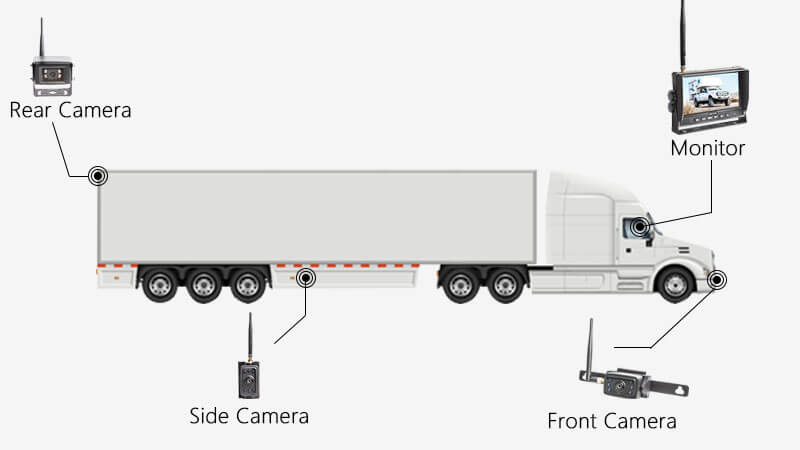Introduction
Driving a semi-truck comes with inherent risks, particularly when navigating blind spots. A Blind Spot Camera For Semi Trucks provides drivers with a clear view of hard-to-see areas, reducing accidents and improving overall road safety. With the right system, operators can maneuver with confidence, avoid collisions, and protect both cargo and lives.

What Is a Blind Spot Camera For Semi Trucks?
People Also Ask: What does a blind spot camera do for a semi truck?
A Blind Spot Camera For Semi Trucks is a specialized camera system installed around the vehicle to monitor blind zones that mirrors cannot fully cover. The system provides a live video feed to the cab, alerting drivers to nearby vehicles, pedestrians, or obstacles.
Read too: Franklin Truck Parts Near Me: Your Complete Guide to Local Truck Parts & Repair Solutions
Key Features:
- Wide-angle lens for maximum coverage
- Real-time video display on a cab monitor
- Night vision or low-light capability
- Optional audio or visual alerts for proximity
According to the National Highway Traffic Safety Administration (NHTSA), blind spots contribute to over 20% of semi-truck side collisions, making camera systems a critical safety tool.
Benefits of Installing Blind Spot Cameras
People Also Ask: Why should I install a blind spot camera on my semi-truck?
Advantages vs Disadvantages:
| Advantages | Disadvantages |
|---|---|
| Increased visibility and safety | Initial cost for equipment and installation |
| Reduced collision risk | Requires driver training to interpret video feed |
| Easier lane changes and turns | Maintenance of cameras and wiring |
| Compliance with fleet safety regulations | Potential blind spots if improperly mounted |
By installing a blind spot camera, fleet operators can significantly reduce accident rates and improve driver confidence.
How to Choose the Right Blind Spot Camera System
People Also Ask: What should I consider when choosing a blind spot camera for semi trucks?
- Camera Type: Choose between fixed, adjustable, or multi-camera systems.
- Display Options: Single or split-screen monitors depending on fleet needs.
- Durability: Look for weather-resistant, shockproof cameras rated for heavy-duty use.
- Night Vision: Infrared or low-light technology improves safety during nighttime operations.
- Integration: Ensure compatibility with existing in-cab systems, GPS, or telematics.
Pro Tip: Some advanced systems offer AI-assisted alerts that detect lane changes, objects, or pedestrians automatically.
Step-by-Step Installation Guide
- Plan Mounting Locations: Identify all blind spot areas—side mirrors, rear, and trailer connection points.
- Install Cameras: Mount securely using brackets; ensure proper angle coverage.
- Route Wiring: Connect power and video cables to the in-cab monitor safely.
- Configure Display: Adjust angles, brightness, and contrast on the monitor.
- Test System: Drive slowly to verify coverage and alert functionality.
Tip: Use cable ties and protective conduits to prevent wire damage during operation.
Maintenance Tips for Optimal Performance
People Also Ask: How do I maintain blind spot cameras on semi trucks?
- Daily: Wipe lenses to remove dirt, dust, or snow.
- Weekly: Inspect mounting brackets and wiring for wear or damage.
- Monthly: Check monitor calibration and video feed clarity.
- Annually: Update software or firmware if applicable.
Proper maintenance ensures continuous visibility, preventing blind spot-related accidents.
Common Issues and Solutions
- Glare or Poor Visibility: Adjust camera angle or install sunshades on monitors.
- Signal Interference: Check cable integrity and routing.
- Dirty Lenses: Clean regularly with soft, non-abrasive cloth.
- Camera Misalignment: Periodically recheck angles, especially after rough terrain operation.
By proactively addressing these issues, drivers maintain optimal safety.
FAQ Section
Q1: Are blind spot cameras mandatory for semi trucks?
A1: Not yet federally mandated, but many fleets adopt them voluntarily for safety compliance and insurance benefits.
Q2: Can I install cameras on any semi-truck model?
A2: Most modern and older trucks can be retrofitted, though installation may vary by truck design.
Q3: Do cameras replace mirrors entirely?
A3: No, they supplement mirrors, providing additional views for safer driving.
Q4: How much does a blind spot camera system cost?
A4: Systems range from $200 to $1,500 per truck depending on features and number of cameras.
Q5: Can these cameras work at night or in bad weather?
A5: Yes, systems with night vision or infrared functionality ensure visibility in low-light conditions.
Q6: Is training required for drivers?
A6: Yes, drivers should familiarize themselves with monitor displays and alert functions for maximum safety.
Conclusion
Installing a Blind Spot Camera For Semi Trucks dramatically improves road safety, reduces collisions, and enhances driver confidence. Choosing the right system, following proper installation steps, and maintaining cameras regularly ensures your fleet stays efficient and protected. Share this guide with other operators to promote safer trucking practices!
Leave a Reply